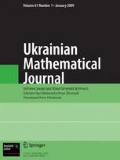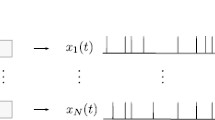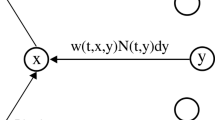The instantaneous state of a neural network consists of both the degree of excitation of each neuron and the positions of impulses in communication lines between the neurons. In neurophysiological experiments, the times of neuronal firing are recorded but not the state of communication lines. However, future spiking moments substantially depend on the past positions of impulses in the lines. This suggests that the sequence of intervals between firing moments (interspike intervals, ISI) in the network can be non-Markovian. In the present paper, we analyze this problem for the simplest possible neural “network,” namely, for a single neuron with delayed feedback. The neuron receives excitatory input both from the input Poisson process and from its own output through the feedback line. We obtain exact expressions for the conditional probability density P(t n+1 | t n ,…,t 1, t 0)dt n+1 and prove that P(t n+1 | t n ,…,t 1, t 0) is not reduced to P(t n+1 | t n ,…,t 1) for any n ≥ 0: This means that the output ISI stream cannot be represented as a Markov chain of any finite order.
Similar content being viewed by others
References
G. L. Gerstein and B. Mandelbrot, “Random walk models for the spike activity of a single neuron,” Biophys. J., 4, 41–68 (1964).
V. S. Korolyuk, P. G. Kostyuk, B. Ya. Pjatigorskii, and E. P. Tkachenko, “Mathematical model of spontaneous activity of some neurons in the CNS,” Biofizika, 12, 895–899 (1967).
J. G. Nicholls, A. R. Martin, B. G. Wallace, and P. A. Fuchs, From Neuron to Brain, Sinauer Associates, Sunderland (2001).
S. Ghosh-Dastidar and H. Adeli, “Spiking neural networks,” Int. J. Neural Systems, 19, 295–308 (2009).
A.V. Holden, “Models of the stochastic activity of neurons,” Lect. Notes Biomath., 12 (1976).
P. Bressloff, “Stochastic neural field theory and the system-size expansion,” SIAM J. Appl. Math., 70, 1488–1521 (2009).
T. Britvina and J. J. Eggermont, “A Markov model for interspike interval distributions of auditory cortical neurons that do not show periodic firings,” Formal Asp. Comput., 96, 245–264 (2007).
M. A. Buice and J. D. Cowan, “Statistical mechanics of the neocortex,” Progr. Biophys. Molec. Biol., 99, 53–86 (2009).
S. B. Lowen and M. C. Teich, “Auditory-nerve action potentials form a nonrenewal point process over short as well as long time scales,” J. Acoust. Amer., 92, 803–806 (1992).
M. W. Levine, “Firing rates of a retinal neuron are not predictable from interspike interval statistics,” Biophys. J., 30, 9–26 (1980).
R. Ratnam and M. E. Nelson, “Nonrenewal statistics of electrosensory afferent spike trains: Implications for the detection of weak sensory signals,” J. Neurosci., 20, No. 17, 6672–6683 (2000).
P. König, A. K. Engel, and W. Singer, “Integrator or coincidence detector? The role of the cortical neuron revisited,” Trends Neurosci., 19, No. 4, 130–137 (1996).
A. K. Vidybida, “Information processing in a pyramidal-type neuron,” BioNet’96—Biologieorientierte Informatik und pulspropagierende Netze, Third Workshop, November 14–15, 1996 (Berlin) (1996), pp. 96–99.
M. Rudolph and A. Destexhe, “Tuning neocortical pyramidal neurons between integrators and coincidence detectors,” J. Comput. Neurosci., 14, No. 3, 239–251 (2003).
B. N. Lundstrom, S. Hong, M. H. Higgs, and A. L. Fairhall, “Two computational regimes of a single-compartment neuron separated by a planar boundary in conductance space,” Neural Comput., 20, 1239–1260 (2008).
A. K. Vidybida, “Inhibition as binding controller at the single neuron level,” BioSystems, 48, 263–267 (1998).
D. M. MacKay, “Self-organization in the time domain,” in: M. C. Yovitts, G. T. Jacobi, et al. (editors), Self-Organizing Systems, Spartan Books, Washington (1962), pp. 37–48.
A. R. Damasio, “The brain binds entities and events by multiregional activation from convergence zones,” Neural Comput., 1, No. 1, 123–132 (1989).
R. Eckhorn, R. Bauer, W. Jordan, M. Brosch, W. Kruse, M. Munk, and H. J. Reitboeck, “Coherent oscillations: a mechanism for feature linking in the visual cortex?,” Biol. Cybernet., 60, No. 2, 121–130 (1988).
A. K. Engel, P. König, A. K. Kreiter, C. M. Gray, and W. Singer, “Temporal coding by coherent oscillations as a potential solution to the binding problem: physiological evidence,” in: H. G. Schuster and W. Singer (editors), Nonlinear Dynamics and Neuronal Networks, VCH, Weinheim (1991), pp. 3–25.
A. K. Vidybida, “Output stream of a binding neuron,” Ukr. Mat. Zh., 59, No. 12, 1619–1638 (2007); English translation: Ukr. Math. J., 59, No. 12, 1819–1839 (2007).
R. Miles, “Synaptic excitation of inhibitory cells by single CA3 hippocampal pyramidal cells of the guinea-pig in vitro,” J. Physiol., 428, 61–77 (1990).
B. Barbour, “Synaptic currents evoked in Purkinje cells by stimulating individual granule cells,” Neuron., 11, 759–769 (1993).
P. Andersen, “Synaptic integration in hippocampal neurons,” Fidia Res. Found. Neurosci. Award Lect., Raven Press, New York (1991), pp. 51–71.
P. Andersen, M. Raastad, and J. F. Storm, “Excitatory synaptic integration in hippocampal pyramids and dentate granule cells,” Cold Spring Harbor Symp. Quant. Biology, Cold Spring Harbor Laboratory Press, Cold Spring Harbor (1990), pp. 81–86.
V. Aroniadou-Anderjaska, M. Ennis, and M. T. Shipley, “Dendrodendritic recurrent excitation in mitral cells of the rat olfactory bulb,” J. Neurophysiol., 82, 489–494 (1999).
J. M. Bekkers and C. F. Stevens, “Excitatory and inhibitory autaptic currents in isolated hippocampal neurons maintained in cell culture,” Proc. Nat. Acad. Sci. USA, 88, 7834–7838 (1991).
V. Chan-Palay, “The recurrent collaterals of Purkinje cell axons: a correlated study of rat’s cerebellar cortex with electron microscopy and the Golgi-method,” Z. Anat. Entwicklungsgesch., 134, 210–234 (1971).
J. Lübke, H. Markram, M. Frotscher, and B. Sakmann, “Frequency and dendritic distribution of autapses established by layer 5 pyramidal neurons in the developing rat neocortex: comparison with synaptic innervation of adjacent neurons of the same class,” J. Neurosci., 16, 3209–3218 (1996).
R. A. Nicoll and C. E. Jahr, “Self-excitation of olfactory bulb neurones,” Nature, 296, 441–444 (1982).
M. R. Park, J. W. Lighthall, and S. T. Kitai, “Recurrent inhibition in the rat neostriatum,” Brain Res., 194, 359–369 (1980).
G. Tamás, E. H. Buhl, and P. Somogyi, “Massive autaptic self-innervation of GABAergic neurons in cat visual cortex,” J. Neurosci., 17, 6352–6364 (1997).
H. Van der Loos and E. M. Glaser, “Autapses in neocortex cerebri: synapses between a pyramidal cell’s axon and its own dendrites,” Brain Res., 48, 355–360 (1972).
Y. Wu, F. Kawasaki, and R. W. Ordway, “Properties of short-term synaptic depression at larval neuromuscular synapses in wild-type and temperature-sensitive paralytic mutants of drosophila,” J. Neurophysiol., 93, 2396–2405 (2005).
J. L. Doob, Stochastic Processes, Wiley, New York (1953).
A. K.Vidybida and K. G. Kravchuk, “Output stream of binding neuron with delayed feedback,” Eur. Phys. J. B, 72, No. 2, 279–287 (2009).
W. Feller, An Introduction to Probability Theory and Its Applications, Vol. 1, Wiley, New York (1968).
A. K.Vidybida, “Input-output relations in binding neuron,” BioSystems, 89, 160–165 (2007).
A. K.Vidybida, “Output stream of binding neuron with instantaneous feedback,” Eur. Phys. J. B, 65, 577–584 (2008); 69, 313 (2009).
F. Farkhooi, M. F. Strube-Bloss, and M. P. Nawrot, “Serial correlation in neural spike trains: Experimental evidence, stochastic modelling, and single neuron variability,” Phys. Rev. E, 79 (2009).
M. P. Nawrot, C. Boucsein, V. Rodriguez-Molina, et al., “Serial interval statistics of spontaneous activity in cortical neurons in vivo and in vitro,” Neurocomputing, 70, 1717–1722 (2007).
B. Cessac, “A discrete time neural network model with spiking neurons: II: Dynamics with noise,” J. Math. Biology, doi:10.1007/s00285-010-0358-4 (2010).
Author information
Authors and Affiliations
Additional information
Published in Ukrains’kyi Matematychnyi Zhurnal, Vol. 64, No. 12, pp. 1587–1609, December, 2012.
Electronic supplementary material
Below is the link to the electronic supplementary material.
Rights and permissions
About this article
Cite this article
Vidybida, A.K., Kravchuk, K.G. Delayed feedback makes neuronal firing statistics non-Markovian. Ukr Math J 64, 1793–1815 (2013). https://doi.org/10.1007/s11253-013-0753-2
Received:
Published:
Issue Date:
DOI: https://doi.org/10.1007/s11253-013-0753-2




